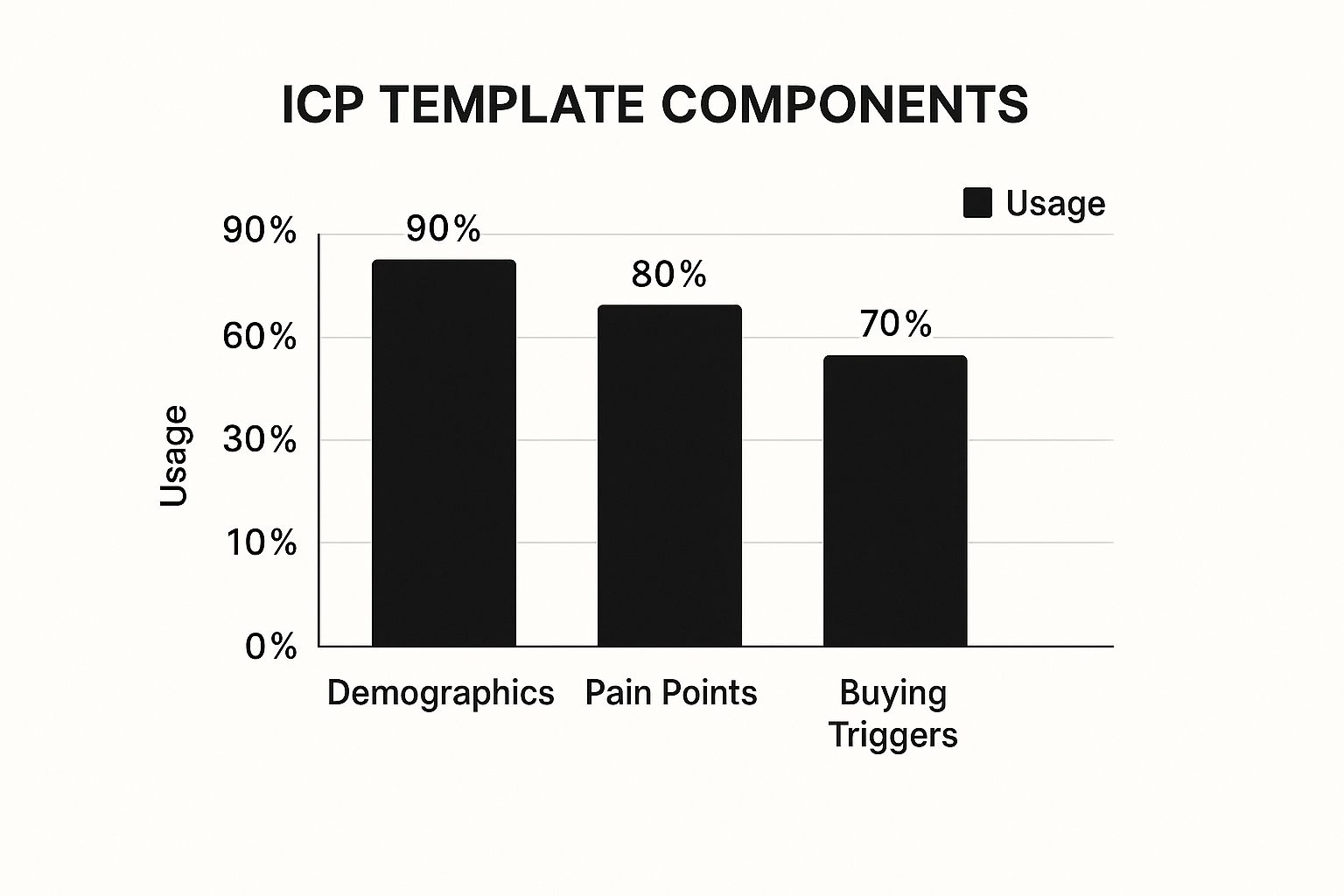
Ideal Customer Profile Template: Build Profiles That Win
Transform your sales with our proven ideal customer profile template. Learn real-world strategies that drive results and boost conversions.
Why Most Customer Profile Templates Fail (And What Works)
Let’s be honest: you’ve probably downloaded an ideal customer profile template, spent an hour filling it with educated guesses, and then watched it gather digital dust in a forgotten folder. It looks professional and ticks a box on a marketing checklist, but it rarely drives any real-world decisions. The problem is that most templates guide you to focus on surface-level details instead of the psychological and business triggers that actually signal a great sale.
A beautifully designed profile filled with vague demographic data like "males aged 25-40" is almost useless. It doesn't tell your sales team why someone is buying, what specific frustration they're trying to fix, or what makes them a better fit than the next person on the list. This is where high-performing teams make a change. They ditch the fluff for a lean, actionable framework.
From Useless to Actionable: The 'Super User' Method
Instead of guessing, the best approach is to look at your existing customers and find your 'super users.' These are the clients who get incredible value from your product, but are also your most profitable and loyal partners. For B2B companies, a great way to start is by reviewing your recent upsells to spot the common traits and behaviors that signal a perfect match.
Solid research suggests an effective profile typically includes six key traits: industry alignment, profitability, readiness to buy, growth potential, company size, and geographical fit. You can find more practical advice on building a data-backed ICP on Cognism's marketing blog.
For example, a platform like Cognism helps sales teams find their ideal customers by going beyond basic info and focusing on detailed, specific data points.

The screenshot shows a clear focus on connecting with ideal buyers, proving that data-driven targeting is far more effective than generic profiling.
Identifying Template Bloat and Focusing on What Matters
So, how do you know if your template is bloated with useless information? Just look for fields that don't directly influence your sales or marketing strategy.
Common "empty calorie" data points often include:
- Vague personality traits like "creative" or "innovative"
- Hobbies or interests that have nothing to do with your product
- Generic goals without business context, such as "wants to grow"
Instead, build your profile around elements that actually drive action:
- Trigger Events: What happened that made them search for a solution like yours? (e.g., they just received a new round of funding or hired a new VP of Sales).
- Success Metrics: How do they measure success in their role? What numbers do they need to hit?
- Tech Stack: What other tools are they already using? This tells you about their operational maturity and potential integrations.
When you shift from a demographic-heavy approach to one centered on behavior and business data, your ideal customer profile template becomes a strategic weapon, not just another document.
Mining Customer Insights That Actually Drive Decisions
Stop drowning in data that looks good in presentations but doesn’t actually change how you sell. The most successful teams are selective, focusing only on insights that lead to real decisions. This means looking past basic demographics to uncover the genuine motivations and behaviors that signal a perfect customer fit. It’s about finding the why behind the buy, not just the who.
To get this right, you need to pull from different places to see the whole picture. Building a solid ideal customer profile template means collecting information from multiple sources. Each source reveals a different piece of the puzzle. For example, surveys and interviews give you direct feedback on customer motivations and challenges, helping you align your product with their actual problems. On the other hand, website analytics provide hard numbers on visitor behavior, showing you what content grabs their attention and where they lose interest. You can find more data collection strategies for your customer profile template on instantly.ai.
Strategic Conversations That Uncover Truth
Often, the best insights come from simply talking to your happiest customers. The trick is to ask the right questions. Forget polite queries that get you generic, rehearsed answers. You need to dig deeper to get the real story.
Try asking questions that reveal genuine pain points:
- "Before you found us, what was the most frustrating part of your day-to-day work?"
- "Can you walk me through the moment you knew your old solution just wasn't cutting it anymore?"
- "What specific event inside your company triggered the search for a new tool like ours?"
These questions bypass surface-level problems and get to the core emotional and business drivers. A customer might initially say their old process was "slow," but a follow-up question could reveal that slowness caused them to miss a critical deadline, which cost their company a major client. Now that’s an insight you can build a sales conversation around.
To get a clearer view of where to get this information, here's a breakdown of common data sources.
Essential Data Sources for Customer Profiling
Comparison of different data collection methods with their strengths, limitations, and best use cases for building comprehensive customer profiles
| Data Source | Primary Insights | Collection Method | Time Investment | Best For | | :--- | :--- | :--- | :--- | :--- | | Customer Interviews | Motivations, pain points, "Aha!" moments, buying triggers | One-on-one video calls, phone calls | High (per customer) | Getting deep, qualitative "why" stories from your best customers. | | Surveys | Satisfaction levels, feature requests, demographic data | Email, in-app pop-ups, tools like SurveyMonkey | Low to Medium | Gathering quantitative data and trends from a larger customer segment. | | Website Analytics | Content engagement, user flow, drop-off points, interests | Google Analytics, heatmaps | Low (ongoing) | Understanding what prospects are interested in before they ever talk to you. | | Sales Team Feedback | Common objections, competitor mentions, frequently asked questions | CRM notes, regular sales meetings | Medium | Capturing real-time insights from the front lines of customer interaction. | | Support Tickets | Product frustrations, usability issues, common problems | Help desk software like Zendesk | Low (ongoing) | Identifying recurring pain points that your product or service can solve. |
This table shows that a mix of methods is necessary. Interviews provide the story, while analytics and surveys provide the scale. Relying on just one source leaves significant blind spots in your customer understanding.
Analyzing Behavior to See What They Won't Say
What customers do is often more telling than what they say. By analyzing behavioral data, you can spot patterns that signal buying intent long before a prospect ever speaks to your sales team.
This infographic shows the most common components found in an effective ideal customer profile template.

The data here is clear: while demographics are a starting point, understanding pain points and buying triggers is just as important for top-performing teams. The key is to find the right balance. By organizing these insights into clear, actionable segments—like "High-Growth Startups with Recent Funding" or "Established Agencies Drowning in Manual Processes"—you empower your team to stop chasing random leads and start engaging predictable sources of revenue.
Mastering Firmographics That Predict Customer Success
When you're in the B2B world, understanding the individual buyer is only half the battle. To really succeed, you need to get a handle on the companies you're selling to. This is where firmographics—the descriptive details of a company—become your secret weapon. But it's not about just checking boxes for company size or industry. The real magic happens when you find the specific combinations of these traits that point to high-value, long-term partners.
This is how you shift from making educated guesses to making decisions backed by your own data. For instance, instead of just targeting "tech companies," you might look at your best customers and realize your sweet spot is actually "SaaS companies with 50-200 employees that recently secured Series B funding." That level of detail changes your outreach from a shot in the dark to a precise, effective strategy.
Identifying Your True Firmographic Triggers
Every business has a unique set of firmographic triggers that signal a perfect match. While industry and company size are great starting points, digging deeper into other attributes will sharpen your focus and improve your results.
When putting together your ideal customer profile template, think about these factors:
- Geographic Location: Are your most successful clients all located in specific cities or regions? This could point to local market needs or network effects.
- Company Structure: Do you have more success with privately held companies, public corporations, or non-profits? Each has different buying processes and priorities.
- Tech Stack: What tools and software do your best customers already use? This can tell you a lot about their operational maturity and their budget for new technology.
- Financial Performance: Do companies with high growth rates or those that have recently received funding convert into customers more quickly? These are often signs that a company is ready to invest in solutions like yours.
Here's a common breakdown of the kinds of firmographic variables you can start tracking.
The screenshot gives a clear outline of key firmographic categories, from industry to performance, offering a solid framework for how you can collect this data. By analyzing these variables within your own customer list, you can pinpoint the exact characteristics that are linked to high close rates and better customer lifetime value.
Putting Firmographics into Action
For any B2B sales team, firmographic data is a core part of the ideal customer profile. Key details like company size—whether measured by employee count or annual revenue—and industry let you customize your entire approach. Think about it: a small SaaS startup with a tight budget needs completely different messaging and pricing than a huge enterprise with massive resources. To see how this fits into the bigger picture, you can learn more about creating a powerful ideal customer profile on copy.ai.
By weighting these factors based on your actual sales data, not just gut feelings, you can build a predictive model. This helps you score new leads and direct your team's energy toward accounts that look just like your past wins. As you gather more data, this process only gets better. You can discover more about how to use AI in your marketing automation to make this targeting even more efficient. This focus makes sure your sales team spends their valuable time on the opportunities most likely to pay off.
Building Customer Segments That Transform Performance
Having a well-defined ideal customer profile is a solid starting point, but the companies that truly pull ahead have figured out how to go deeper. They've mastered meaningful customer segmentation, which lets them tailor every single interaction. Instead of one broad profile, they build several distinct segments based on specific, predictable patterns.
This isn't just about basic company details. It's about spotting the subtle clues that separate a high-potential account from one that will just waste your time. For example, a marketing agency might discover that clients who ask about API integrations during the first call have a 30% higher lifetime value. That’s a powerful behavioral segment. Another trigger event could be "startups that just hired their first Head of Sales," which often signals a major investment in new software.
Building your ideal customer profile template around these dynamic segments is what creates a real competitive advantage. It moves you from guessing to knowing who your best customers are.
Choosing the Right Segmentation Framework
Different business models naturally call for different segmentation strategies. A B2C ecommerce brand might lean on psychographics and purchase history, while a B2B SaaS company will get more out of firmographics and product usage data. The goal is to pick a framework that matches your business objectives and the data you can realistically gather and analyze.
To help you figure out which approach fits best, let's compare some of the most common segmentation models and where they truly make an impact.
To give you a clearer picture, this table breaks down the most common segmentation frameworks and how they stack up for different business needs.
Customer Segmentation Framework Comparison
Analysis of different segmentation approaches with their effectiveness for various business types and customer bases
| Segmentation Type | Primary Focus | Best Business Fit | Implementation Complexity | ROI Potential | | :--- | :--- | :--- | :--- | :--- | | Demographic | Age, income, location, gender | B2C, mass-market retail, local services | Low | Medium | | Psychographic | Lifestyle, values, interests, personality | B2C brands, luxury goods, travel companies | Medium | High | | Behavioral | Purchase history, product usage, engagement | E-commerce, SaaS, subscription services | Medium-High | Very High | | Needs-Based | Specific problems, desired outcomes | B2B, consulting, specialized services | High | Very High | | Value-Based | Customer lifetime value (CLV), profitability | All businesses, especially with varied pricing | High | Very High |
As the table illustrates, while demographic segmentation is the easiest to start with, behavioral and value-based segmentation typically deliver the highest return on investment. These methods require more involved data analysis but provide the actionable insights needed to drive real performance. By focusing your energy on the segments that matter most, you can improve everything from product development to your pricing strategy.
Getting Your Team To Actually Use Customer Profiles
You’ve built a brilliant ideal customer profile template. That's a great first step, but it’s completely useless if it just gathers digital dust in a shared drive. The real challenge isn’t creating the profile; it’s making it a core part of your sales and marketing teams' daily routines. If you don't intentionally drive adoption, even the most insightful profile becomes just another ignored document.
Your goal is to make thinking about the customer a natural reflex, not another box to check. This means you need a plan to get past the usual resistance to new processes. You have to show your team, in practical terms, how these profiles make their jobs easier and more successful.
Driving Adoption in Sales and Marketing
For your sales team, the profiles need to live where they work. If your reps are in the CRM all day, the key customer profile data should be right there on the lead or account page. This simple change transforms the profile from a document they have to hunt down into an immediate tool for personalizing outreach and handling objections on the fly.
Imagine a salesperson pulling up a lead in a CRM like Salesforce. Instead of a blank slate, they see key details about the prospect's company size, industry, and likely challenges.
As you can see, surfacing this info directly in their workflow means they don't have to break their focus to find a separate file. It’s right there when they need it.
For the marketing team, these profiles should be the starting point for every single campaign brief and content idea. A simple checklist can work wonders here:
- Does this ad campaign speak directly to the pain points of our "High-Growth Startup" segment?
- Is the language in this email sequence tailored to the "Established Agency" profile's goals?
- How does this new blog post solve a problem for our ideal customer?
By making this a required step, you build a system of accountability that ensures the profiles are consistently used. It's also incredibly powerful to connect profile usage to real results. Show your team that leads matching the ideal customer profile template have a 25% higher close rate, or that marketing campaigns targeting specific segments get double the engagement. When people see the proof, buy-in happens naturally.
Creating Accountability and Maintaining Buy-In
To make sure the profiles stick, weave them into your regular team meetings. Take five minutes in your weekly sales huddle to break down a recent win and discuss how the customer matched the profile. In marketing syncs, start by asking how the upcoming content calendar serves your key customer segments. This constant reinforcement keeps the profiles from being forgotten.
You can also build a shared library of success stories that highlight the profiles in action.
- Case Study 1: How the sales team used the profile to close a major deal by focusing on a specific, identified pain point.
- Example 2: A marketing campaign that crushed its goals after being redesigned to fit a new customer segment.
This approach creates a culture where being customer-focused isn't just a buzzword—it's how you operate. To learn more about formalizing these efforts, our guide on building an effective content creation workflow can help you structure this process. Ultimately, the key is to make your ideal customer profile an active, living tool, not a static document.
Tracking What Matters: Profile Performance Metrics

Putting together a detailed ideal customer profile template is a huge win, but it’s really just the starting point. How can you be sure it's actually making a difference? The best teams don’t just create a profile and move on; they build a feedback loop to constantly sharpen their understanding with real performance data. This is about shifting your focus from building the profile to measuring its impact on your business goals.
Without tracking, your perfect profile is just a set of well-researched guesses. The real test is whether those guesses lead to actual business growth.
From Theory to Results: Key Metrics to Watch
Instead of getting bogged down by vanity metrics, focus on the numbers that show how effective your customer profiling truly is. These are the indicators that tell you if your sales and marketing efforts are getting sharper and more efficient.
Here are the core metrics you should keep an eye on:
- Lead-to-Opportunity Conversion Rate: Are the leads who fit your new profile turning into real sales opportunities more often? This is the clearest sign that you're attracting the right crowd.
- Sales Cycle Length: A spot-on profile helps you craft messages that address specific problems, which can cut down the time it takes to close a deal. If your sales cycle for profile-aligned deals is getting shorter, you’re doing something right.
- Average Deal Size: By definition, ideal customers should see more value in what you offer, often leading to bigger initial purchases. A rising average deal size within your target segment is a great sign.
- Customer Acquisition Cost (CAC) by Segment: Are you spending less money to bring in customers who match your profile? Smart targeting should lower your marketing spend and sales effort per customer, which directly improves your CAC.
Designing a Continuous Improvement Process
Your profile shouldn't be a static document set in stone. Markets shift, customer needs change, and your own product gets new features. To keep your profile relevant, you need a regular review process that pulls in insights from across your entire company. A quarterly audit is a fantastic place to start.
During these audits, get your marketing, sales, and customer success teams in the same room. Talk about what’s working and what isn't. Your sales team can tell you which profile traits are genuinely predictive, while customer success can share which customers are seeing the best results and are happiest. This teamwork turns your ideal customer profile template into a living document that gets smarter with time.
You can also explore some of the top AI marketing software to help automate some of this tracking and analysis, freeing up your team to think bigger. This ongoing refinement ensures you stay perfectly aligned with your most valuable customers.
Scaling Your Customer Profile Success
An ideal customer profile template is more than just a document—it’s a growth engine for your business. The smartest companies I've seen don't just use their profiles for sales outreach. They weave these customer insights into every big decision, from planning their product roadmap to exploring new markets. This turns the profile from a simple sales tool into a real, systematic advantage that grows with you. But as your business expands, keeping that profile sharp and accurate while finding new customers is the real challenge.
Evolving Your Profile Without Losing Focus
The trick to scaling is to let your profile evolve gradually. Making huge, sudden changes can disrupt what’s already working. Your first profile, built from your best customers, is your foundation. As you enter new markets or launch new products, you're not starting over; you're just testing variations of that core profile.
Think of it this way: your original ideal customer profile template is your control group. If you're eyeing a new market, you might have a theory that the perfect company size is larger there, or maybe a different pain point is more pressing. You can test this by targeting a small group based on that new theory and then measuring the results against what you already know works.
- Lead Quality: Are the leads from this new segment turning into opportunities at a similar or even better rate?
- Sales Cycle: Are you closing deals faster, slower, or in about the same amount of time?
- Customer Feedback: Do these new customers seem just as happy? Are they getting the same great results?
By tracking these simple metrics, you can prove or disprove your theory with actual data before you pour a ton of resources into it. This methodical approach lets you adapt your customer profiles without losing the core insights that made you successful in the first place.
Implementation and Maintenance for Long-Term Growth
To make this work as you grow, you need a clear plan for implementing and maintaining your profiles. Don't just wait until they feel stale. I recommend scheduling regular reviews to keep them fresh and relevant.
Actionable Implementation Strategies:
- Quarterly Profile Audits: Set up a recurring meeting every three months with leaders from sales, marketing, and customer success. Use that time to talk about what's changing in the market and look at the performance data for each customer segment you're targeting.
- Document New Learnings: Create one central place—like a shared document or a dedicated Slack channel—where your team can log new insights as they happen. Did a big deal just close for a surprising reason? Log it. Did a customer leave for an unexpected reason? Log that, too.
- Realistic Timelines: It can take 3-6 months to see clear, meaningful results from targeting a new segment. My advice? Be patient and trust the process.
This ongoing maintenance ensures your ideal customer profile template stays a living, breathing guide that reflects what's really happening with your customers and in your market. It’s how you scale your business intelligently.
Ready to create social media content that speaks directly to your ideal customer? ViewPrinter gives you the AI-powered tools to create engaging slideshows and video ads tailored to your specific customer profiles. Discover how ViewPrinter can scale your content creation today!